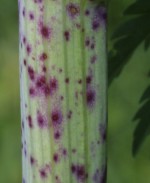 The name “poison hemlock” conjures up visions of Socrates drinking his fatal brew as shown by the French painter Jacques-Louis David. A brew containing poison hemlock was given to condemned prisoners in ancient Athens and Socrates had been tried and found guilty of impiety with the penalty of death. Poison hemlock is a member of the carrot family and related to parsnips, parsley and Queen Anne’s lace, not evergreen hemlocks.
The name “poison hemlock” conjures up visions of Socrates drinking his fatal brew as shown by the French painter Jacques-Louis David. A brew containing poison hemlock was given to condemned prisoners in ancient Athens and Socrates had been tried and found guilty of impiety with the penalty of death. Poison hemlock is a member of the carrot family and related to parsnips, parsley and Queen Anne’s lace, not evergreen hemlocks. A native of Europe and the Middle East, this biennial weed was introduced into North America in the 1800s as an ornamental and can be found in most of the United States. It is considered invasive in 12 states, including California. It prefers wet places in sun to partial shade such as low spots in pastures, wet open woodlands, drainage ditches, and the banks along streams and ponds. It rarely appears in gardens but since all parts are poisonous it should be identified and removed immediately when it does appear. Poisonous carrots resembles several other plants especially wild carrot but can be distinguished from most by its hairless stems with purple spots, rounded flower heads, and tall stature.
A native of Europe and the Middle East, this biennial weed was introduced into North America in the 1800s as an ornamental and can be found in most of the United States. It is considered invasive in 12 states, including California. It prefers wet places in sun to partial shade such as low spots in pastures, wet open woodlands, drainage ditches, and the banks along streams and ponds. It rarely appears in gardens but since all parts are poisonous it should be identified and removed immediately when it does appear. Poisonous carrots resembles several other plants especially wild carrot but can be distinguished from most by its hairless stems with purple spots, rounded flower heads, and tall stature.
 Plants first appear in the fall or early spring forming a rosette of basal leaves 1-1 ½’ across. These leaves are fern-like; they are alternate, two to four times pinnately compound, 18” long x 12” wide, hairless, and have long petioles. In the spring, the rosette produces an erect, branching, flowering stem that is round, hallow except at the nodes, lacking hairs, green with purple spots, and grows three to ten feet tall. The stem leaves resemble the basal ones in appearance by are smaller and have shorter petioles as they ascend. Small white flowers are produced at the tips of branches in slightly rounded compound umbels 2 to 5 inches across from late spring to summer. Flowers are followed by fruits with two seeds that germinate to produce rosettes in the fall or early spring. The root system is a thick fleshy taproot.
Plants first appear in the fall or early spring forming a rosette of basal leaves 1-1 ½’ across. These leaves are fern-like; they are alternate, two to four times pinnately compound, 18” long x 12” wide, hairless, and have long petioles. In the spring, the rosette produces an erect, branching, flowering stem that is round, hallow except at the nodes, lacking hairs, green with purple spots, and grows three to ten feet tall. The stem leaves resemble the basal ones in appearance by are smaller and have shorter petioles as they ascend. Small white flowers are produced at the tips of branches in slightly rounded compound umbels 2 to 5 inches across from late spring to summer. Flowers are followed by fruits with two seeds that germinate to produce rosettes in the fall or early spring. The root system is a thick fleshy taproot.
Hand pulling the plants before they have developed extensive roots is effective but washable gloves should be worn because of the poisonous nature of the plant. Mowing or spraying with an herbicide such as glyphosate before flowering may be necessary in heavily infested areas.